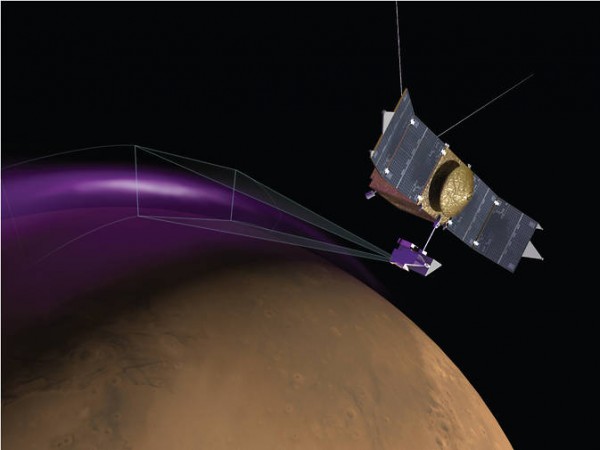NASA's MAVEN Spacecraft Spots Mystery Cloud and Ultraviolet Aurora on Mars
| Ana Verayo | | Mar 19, 2015 07:50 AM EDT |
(Photo : University of Colorado) Artist’s conception of MAVEN’s Imaging UltraViolet Spectrograph (IUVS) observing the “Christmas Lights Aurora" on Mars.
During a recent flyby of the Red Planet, NASA's Mars Atmosphere and Volatile Evolution (MAVEN) spacecraft discovered a mysterious dust cloud and a strange aurora on the alien world.
In an unusual set of circumstances, dust accumulated over orbital altitudes of 93 miles to 190 miles above the surface of Mars. The composition of the dust along with its original source are still unknown but these phenomenon pose no danger to orbiting probes around Mars such as MAVEN.
Like Us on Facebook
This mysterious cloud was detected by MAVEN's Langmuir Probe and Waves (LPW) instrument. Scientists are still trying to determine if this cloud is permanent or just a temporary phenomenon.
The instrument detected the cloud density was at its greatest in lower altitudes but the densest parts of the clouds can still be considered as relatively thin. The cloud wasn't even detected by other scientific instruments aboard MAVEN during its recent observations of the planet.
Scientists believe the likely sources of the mystery cloud could have be dust found in the atmosphere or even dust from Martian moons, Phobos and Deimos. Other theories suggest that the solar wind is also responsible for the dust uprising.
There is still no known geological or metrological process on Mars that can explain the occurrence of dust clouds in many regions of the planet.
Apart from this ominous dust cloud, an aurora was also recently observed on Mars. MAVEN's Imaging Ultraviolet Spectrograph (IUVS) detected the aurora and dubbed it the "Christmas Lights" during December 2014.
This bright ultraviolet aurora light show on the alien world spanned the entire northern hemisphere. It lasted for five days, which is also similar to the spectacular light show on Earth.
According to Arnaud Stiepen, IUVS team member of the University of Colorado, what's surprising about this Martian aurora is that it occurs deep within the atmosphere unlike Earth's; meaning the electrons in the Martian aurora must really be energized.
The Aurora borealis or the Northern Lights on Earth are caused by energy particles from electrons emitted by solar flares assaulting the magnetosphere, causing them to glow eerily in hues of many colors.
TagsNASA's MAVEN Spacecraft Spots Mystery Cloud and Ultraviolet Aurora on Mars, NASA, MAVEN, Mars, Aurora Borealis, Mars aurora dust cloud MAVEN NASA
©2015 Chinatopix All rights reserved. Do not reproduce without permission
EDITOR'S PICKS
-

Did the Trump administration just announce plans for a trade war with ‘hostile’ China and Russia?
-

US Senate passes Taiwan travel bill slammed by China
-

As Yan Sihong’s family grieves, here are other Chinese students who went missing abroad. Some have never been found
-

Beijing blasts Western critics who ‘smear China’ with the term sharp power
-

China Envoy Seeks to Defuse Tensions With U.S. as a Trade War Brews
-

Singapore's Deputy PM Provides Bitcoin Vote of Confidence Amid China's Blanket Bans
-

China warns investors over risks in overseas virtual currency trading
-

Chinese government most trustworthy: survey
-

Kashima Antlers On Course For Back-To-Back Titles
MOST POPULAR
LATEST NEWS
Zhou Yongkang: China's Former Security Chief Sentenced to Life in Prison

China's former Chief of the Ministry of Public Security, Zhou Yongkang, has been given a life sentence after he was found guilty of abusing his office, bribery and deliberately ... Full Article
TRENDING STORY

China Pork Prices Expected to Stabilize As The Supplies Recover

Elephone P9000 Smartphone is now on Sale on Amazon India

There's a Big Chance Cliffhangers Won't Still Be Resolved When Grey's Anatomy Season 13 Returns

Supreme Court Ruled on Samsung vs Apple Dispute for Patent Infringement

Microsoft Surface Pro 5 Rumors and Release Date: What is the Latest?










